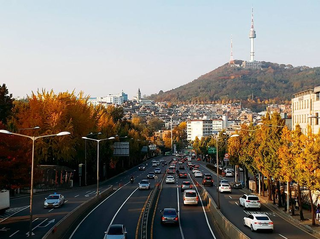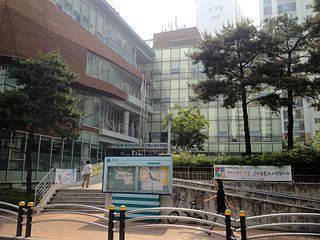
Yongsan District is one of the 25 districts of Seoul, South Korea.

Seocho District is one of the 25 local government districts which make up the city of Seoul, South Korea. Seocho is a part of the Gangnam region, along with the Gangnam district of Seoul. Seocho District ranks as one of the richest neighborhoods in South Korea and among the most expensive areas in Seoul with an average sales price of 47.75 million South Korean won per 3.3 square meters. Many of the wealthiest residents are concentrated in the three Gangnam districts including Seocho, known as Gangnam School District Eight.

Jamwon-dong is a dong, neighbourhood of the greater Gangnam area Seocho-gu in Seoul, South Korea. Until 1988, Jamwon-dong was under the jurisdiction of Gangnam-gu. Jamwon-dong is popular for its mulberry trees and silkworms, whose cocoon is used to make fabric for clothing. As a legal-status neighborhood, Jamwon-dong includes Banpo 3-dong and Jamwon-dong.

Banpo-dong is a dong, neighborhood of Seocho District, the greater Gangnam area in Seoul, South Korea. Banpo-dong is divided into five different dong which are Banpobon-dong, Banpo 1-dong, 2-dong, 3-dong and 4-dong.

Sillim-dong (Korean: 신림동) is a dong (neighborhood) of Gwanak District, Seoul, South Korea. Seoul National University and Nokdu Street are located in the town. Its name means "new forest", which was derived from the woods outstretched from Mt. Gwanak. It consists 11 administrative neighbourhoods.

Hannam-dong (Korean: 한남동) is a wealthy dong (neighborhood)of Yongsan District, Seoul, South Korea. It has been portrayed continuously in South Korea's popular culture as an oasis of wealth and luxury, thus becoming the subject of numerous domestic films, television series, and popular music references.

Ichon-dong is a neighborhood of Yongsan District, Seoul, South Korea. It is located in the southwest of the city proper, along the Han River.

Wonhyoro-dong is a dong, neighbourhood of Yongsan-gu in Seoul, South Korea.

Yongmun-dong is a dong, neighbourhood of Yongsan-gu in Seoul, South Korea.

Namyeong-dong is a dong, neighbourhood of Yongsan-gu in Seoul, South Korea.
Seogye-dong (Korean: 서계동) is a dong, neighbourhood of Yongsan-gu in Seoul, South Korea. It is a legal dong administered under its administrative dong, Cheongpa 1-dong.
Munbae-dong is a dong, neighbourhood of Yongsan-gu in Seoul, South Korea. It is a legal dong administered under its administrative dong, Hangangno 1-dong
Singye-dong is a dong, neighbourhood of Yongsan-gu in Seoul, South Korea. It is a legal dong administered under its administrative dong, Hangangno 1-dong
Dongbinggo-dong is a dong (neighborhood) of Yongsan District, Seoul, South Korea. It is a legal dong administered under its administrative dong, Seobinggo-dong
Juseong-dong is a dong, neighbourhood of Yongsan-gu in Seoul, South Korea. It is a legal dong administered under its administrative dong, Seobinggo-dong
Sancheon-dong is a dong, neighbourhood of Yongsan-gu in Seoul, South Korea. It is a legal dong administered under its administrative dong, Wonhyoro 2-dong
Sinchang-dong is a dong, neighbourhood of Yongsan-gu in Seoul, South Korea. It is a legal dong administered under its administrative dong, Wonhyoro 2-dong
Tongin-dong is a dong, neighbourhood of Jongno-gu in Seoul, South Korea. It is a legal dong administered under its administrative dong, Hyoja-dong.
Jeong-dong is a legal dong, or neighbourhood of the Jung-gu district in Seoul, South Korea and governed by its administrative dong, Sogong-dong.

The Banpo Bridge (Korean: 반포대교) is a major bridge for vehicular traffic over the Han River in central Seoul, South Korea. It is a double-decked bridge, and is above the pedestrian Jamsu Bridge.












